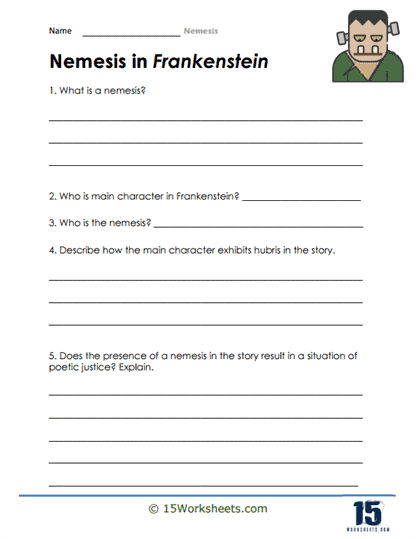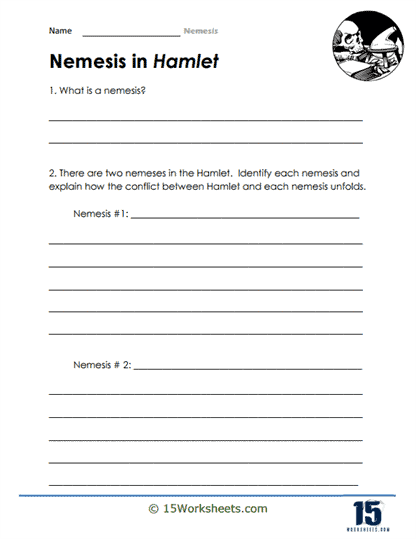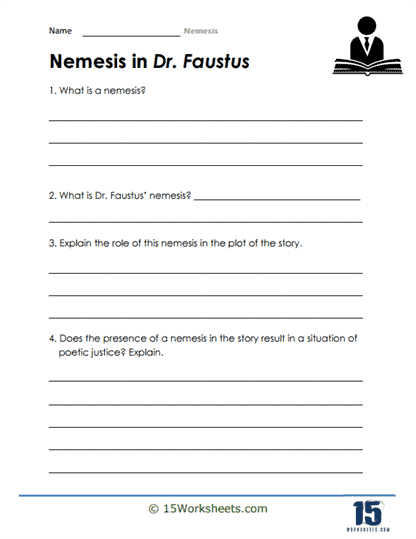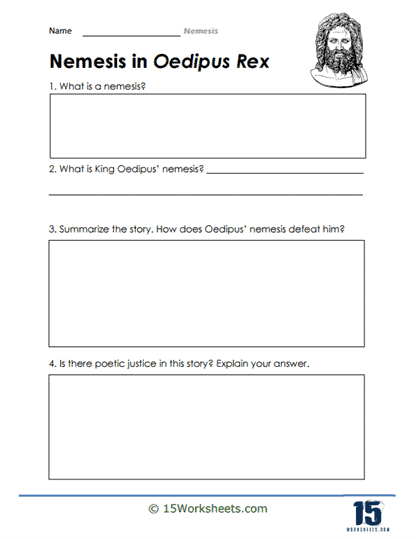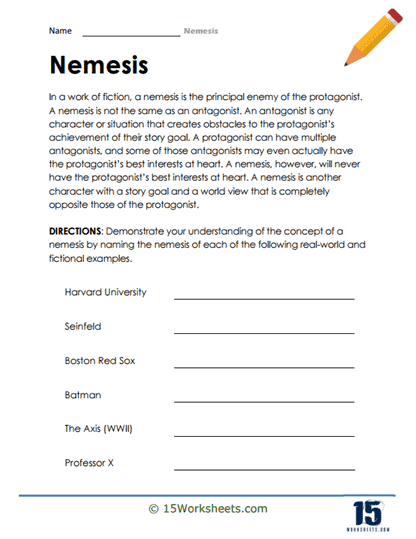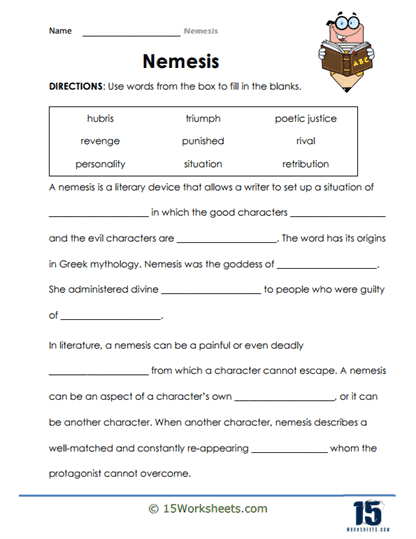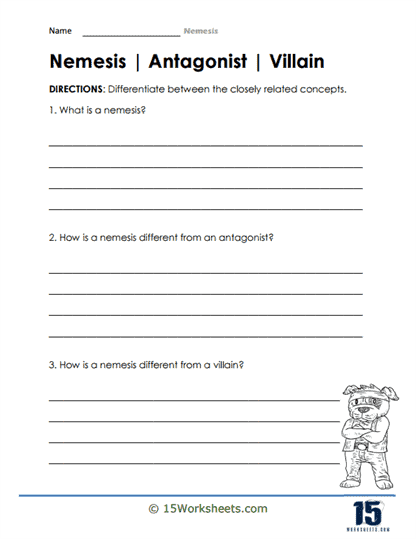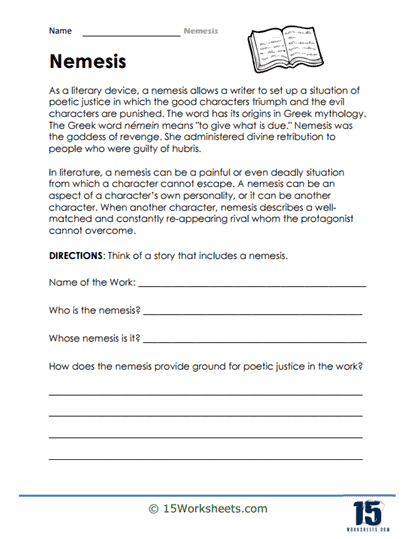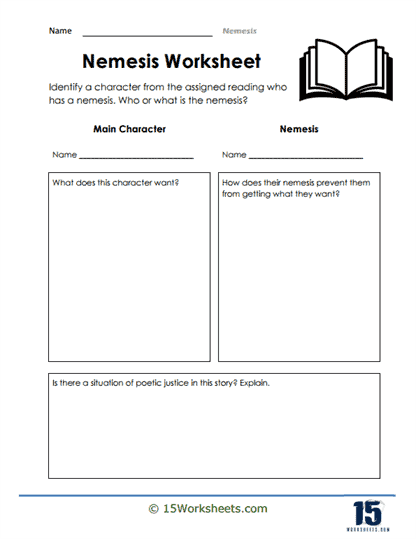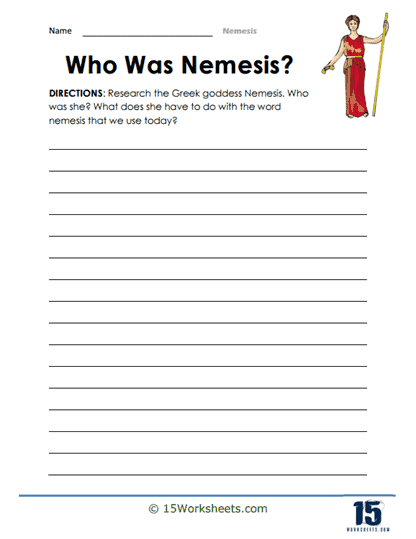Nemesis Worksheets
About These 15 Worksheets
These worksheets serve as structured learning resources aimed at exploring and comprehending the literary device of nemesis. Nemesis, derived from Greek mythology, represents the concept of inevitable punishment or retribution, often enacted by a character or force in response to wrongdoing or hubris. These worksheets typically provide excerpts from literary works where the theme of nemesis is evident, prompting students to identify and analyze instances of nemesis.
The worksheets include a series of questions and exercises that encourage critical thinking and deep engagement with the text, such as identifying the actions or traits that lead to the nemesis, examining the consequences of the nemesis, and evaluating its significance within the context of the story. Students may also be prompted to explore the role of nemesis in character development, plot progression, and thematic exploration. Through these activities, students not only enhance their understanding of the literary device of nemesis but also develop their analytical skills and ability to interpret complex literary themes.
By systematically working through these rigorous exercises, students can significantly enhance their language comprehension, vocabulary, analytical skills, and writing proficiency. These worksheets serve not only to improve academic performance but also to prepare students for the complexities of real-world communication and analysis, setting a strong foundation for lifelong learning and critical thinking.
Types of Exercises
Nemesis Worksheets comprise a diverse array of exercises tailored to address every facet of language arts. Each type of exercise focuses on developing specific skills or knowledge areas. Here are the primary categories:
Vocabulary Enrichment Exercises
These exercises push students to broaden their vocabulary through context clues, synonyms and antonyms, word origins, and the study of prefixes and suffixes. Unlike basic vocabulary drills, Nemesis Worksheets present challenging and unfamiliar words in complex sentences or scenarios, requiring deeper analytical thinking to understand and apply each word.
Reading Comprehension Challenges
Reading comprehension sections in these worksheets feature complex texts from a wide range of genres, including classical literature, technical writing, poetry, and contemporary non-fiction. Questions focus on inferencing, main idea, themes, author’s purpose, and critical analysis, requiring students to engage deeply with the text and hone their analytical skills.
Grammar and Syntax Drills
Advanced grammar and syntax drills test students on more than just the basics of grammar rules; they introduce complex sentence structures, nuances of language use, and common errors in advanced writing. These exercises help students refine their writing and editing skills by identifying and correcting errors in sentence structure, punctuation, and syntax in challenging passages.
Writing and Composition Tasks
Writing exercises in Nemesis Worksheets are designed to stretch students’ abilities to express themselves clearly and creatively. Prompts may require students to write persuasive essays, narratives, research papers, and responses to literature, with a focus on developing a strong thesis, coherent structure, and compelling arguments or narratives.
Critical Thinking and Analysis
These exercises encourage students to go beyond surface-level understanding and engage in deeper literary analysis and critique. Students might analyze the themes, motifs, and symbols in complex literary works, compare and contrast texts, or evaluate arguments and perspectives in non-fiction texts, fostering a higher level of critical thinking and interpretation.
The Benefits of These Worksheets
Practicing with Nemesis Worksheets can significantly enhance students’ language arts and reading skills in several ways:
Enhanced Vocabulary and Expression – By exposing students to a broader and more challenging set of vocabulary, Nemesis Worksheets improve students’ ability to express themselves more precisely and understand complex texts.
Improved Reading Comprehension – Through engagement with complex texts and deep analytical questions, students develop a keener ability to understand subtle nuances, infer meanings, and critically evaluate texts, enhancing both their reading speed and comprehension.
Refined Writing Skills – The rigorous writing exercises push students to improve their writing structure, clarity, and creativity, enabling them to express their thoughts in a more organized and impactful manner.
Advanced Grammar Mastery – By tackling advanced grammar and syntax challenges, students refine their editing skills and gain a more nuanced understanding of language mechanics, leading to fewer errors and more polished writing.
Critical Thinking and Analytical Skills – The critical thinking and analysis exercises foster a deeper understanding of literature and texts, enabling students to engage with material in a more meaningful way and develop their own insights and interpretations.
What is the Literary Device of Nemesis?
The literary device of Nemesis refers to an indispensable mechanism within storytelling, representing the inevitable or unavoidable counter to a protagonist’s ambitions or actions, often manifesting as a character, force, or situation that ensures retribution or justice is served. This device roots deeply in ancient Greek mythology, where Nemesis was the goddess of retribution, embodying the moral balance for hubris and undue fortune. In literature, the concept has evolved to embody the broader idea of an unavoidable adversary or obstacle, often pivotal in driving narratives towards their climax and resolution.
Defining Feature of a Nemesis
The main defining feature of a Nemesis is its role as the ultimate antagonist or opposing force that directly challenges the protagonist, embodying the consequences of the protagonist’s actions or character flaws. Unlike typical antagonists, a Nemesis is characterized by the inevitability of its confrontation with the protagonist, often arising from or intimately connected to the protagonist’s own decisions, morals, or flaws. This inevitability imbues the narrative with a sense of fate or destiny, underscoring the moral or thematic lessons the protagonist-and, by extension, the reader-must learn.
Characteristics of a Nemesis
Inevitability – A Nemesis is not a random obstacle; it is a direct result of the protagonist’s actions, choices, or nature, making their confrontation unavoidable.
Justice or Retribution – Often, a Nemesis serves as a form of moral balancing, bringing justice or retribution for the protagonist’s hubris, wrongdoings, or moral failings.
Reflection or Contrast – A Nemesis often mirrors or contrasts the protagonist, highlighting their flaws, fears, or desires, and forcing them to confront aspects of themselves they might wish to ignore.
Impartiality – The force of a Nemesis is usually impartial, acting not out of personal vendetta but as a natural consequence of the protagonist’s actions or the universe’s moral law.
Transformation – The encounter with a Nemesis often leads to significant transformation in the protagonist, driving character development and narrative progression.
Examples of Nemesis in Literature
1. Captain Ahab and Moby Dick in “Moby-Dick” by Herman Melville
In “Moby-Dick,” Captain Ahab’s Nemesis is the white whale, Moby Dick, representing Ahab’s obsession and the destructive path it leads him on. Moby Dick is not merely a physical adversary but a manifestation of Ahab’s own hubris, his refusal to respect nature’s power, and his monomaniacal quest for vengeance. The whale’s elusiveness and the final confrontation lead to Ahab’s downfall, illustrating the destructive consequences of obsession and the inevitability of retribution when humanity attempts to dominate nature.
2. Oedipus and Fate in “Oedipus Rex” by Sophocles
In Sophocles’ “Oedipus Rex,” the Nemesis is not a person but the concept of fate itself. Oedipus tries to escape the prophecy that he will kill his father and marry his mother, but his actions inadvertently lead to its fulfillment. Fate serves as the Nemesis, embodying the idea that some outcomes are inescapable, regardless of human effort to avoid them. Oedipus’s downfall is a direct result of his hubris and his attempt to outmaneuver fate, highlighting the theme of inevitable justice and the limitations of human agency.
3. Harry Potter and Lord Voldemort in “Harry Potter” series by J.K. Rowling
In the “Harry Potter” series, Lord Voldemort serves as Harry Potter’s Nemesis, representing the darkness and hatred Harry must confront and overcome. Voldemort is not just a personal enemy but a figure tied to Harry’s destiny, as prophesied before Harry’s birth. Their connection, marked by the attempt on Harry’s life as an infant, makes their final confrontation inevitable. Voldemort embodies the consequences of power corrupted by fear and hatred, while Harry’s journey to confront him is as much about internal growth as it is about external conflict, illustrating the theme of good versus evil and the importance of courage and love.
The Effect of a Nemesis on the Reader
The use of Nemesis in literature has a profound effect on the reader, adding depth and tension to the narrative. This device engages readers by:
Creating Suspense – The inevitability of the confrontation with the Nemesis keeps readers engaged, building suspense as they anticipate the climax.
Enhancing Themes – By embodying moral or thematic lessons, a Nemesis enriches the narrative’s thematic depth, encouraging readers to reflect on the story’s moral implications.
Facilitating Catharsis – The resolution of the conflict with the Nemesis often provides a cathartic experience for the reader, as it brings about a sense of justice, moral realignment, or emotional release.
Encouraging Empathy – Observing the protagonist’s struggle against their Nemesis, readers can find themselves empathizing with the protagonist’s plight, rooting for their success or learning from their failures.

